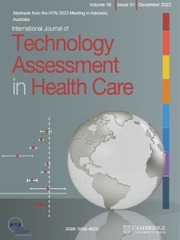We would like to thank the authors of the article “Defining early health technology assessment: building consensus using Delphi technique” (Reference Grutters, Bouttell and Abrishami1) for a very valuable contribution to the field of early assessment. The definition reached in the article is “a health technology assessment conducted to inform decisions about subsequent development, research and/or investment by explicitly evaluating the potential value of a conceptual or actual health technology.” The study is well-executed and employs robust methodology; nevertheless, when the authors attempt to harmonize definitions of various terms for early HTA (Health Technology Assessment), such as early dialogue and development-focused HTA, it is imperative to consider two specific remarks regarding the definition of early assessment.
First, we believe it is important to explicitly mention the stage of the development of the technology in the above definition. Because what exactly is meant by “early” HTA? One suggestion could be to use the concept of the Technology Readiness Level (TRL) of the technology being assessed, and in a study from our team, we suggest using a TRL score of 3–7 to define the early assessment stage (Reference Fasterholdt, Lee, Kidholm, Yderstraede and Pedersen2). TRL is widely used in practice, and next, we deliver some examples from ongoing European Union (EU) projects where the TRL serves as a pivotal concept. For instance, it is used in the EDiHTA project (3), which strives to deliver a flexible, inclusive, validated, and ready-for-use European HTA framework allowing the assessment of different digital health technologies at different TRLs, territorial levels (national, regional, and local), and perspectives (e.g., payer, society, and hospital). Furthermore, the HEU-EFS (Harmonized approach to Early Feasibility Studies) project (4), a European public–private partnership dedicated to developing a harmonized framework across the EU to enhance the adoption of EFS for medical devices, extensively employs the TRL framework to facilitate its objectives.
Second, we consider it important to state in the early assessment definition that the available evidence is limited, as a low evidence level and high uncertainty are what characterize the early assessment stage. In practice, this entails the availability of feasibility, pilot, or initial effect data from early clinical experience and previous generations of the technology in a stage with high (decision) uncertainty. In the article on the early assessment of medical technologies by IJzerman and Steuten (Reference IJzerman and Steuten5), stage and uncertainty are critical elements in a figure that effectively employs a graphical representation to illustrate these concepts. In this article, the stage, type of research, and the underlying decreasing uncertainty over time are key when distinguishing between the three concepts: very early HTA, early HTA, and mainstream HTA.
We consider our two points above to be supported by the discussion section of the commented article by the fact that the authors themselves urge others to report the stage of development and the level of evidence available when performing an early assessment. Hence, we hope our reflections may be taken into account in the future.
Funding statement
This research received no specific grant from any funding agency, commercial, or not-for-profit sectors.
Competing interests
The authors declare none.


